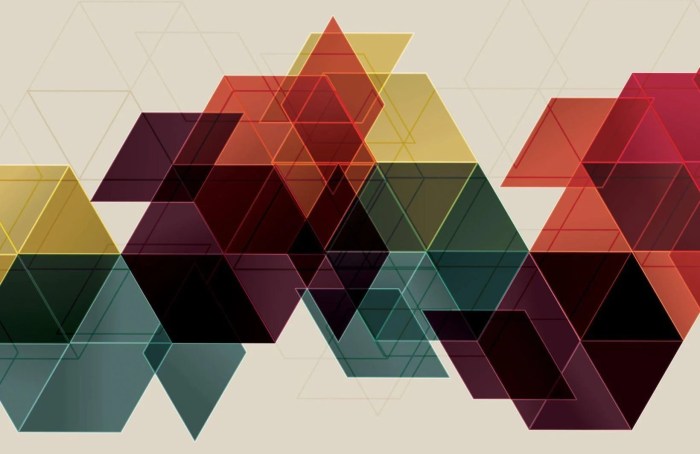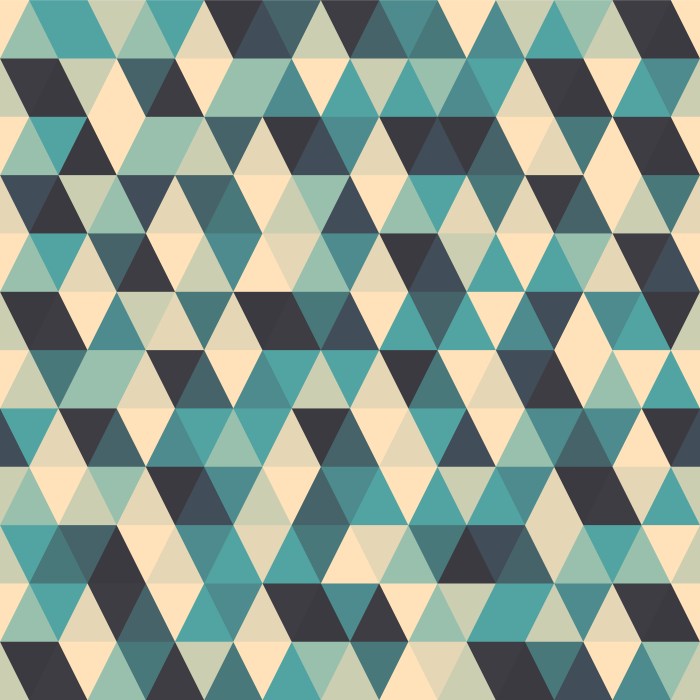Exploring the Beauty of Geometric Design
Geometric design, a harmonious blend of art and mathematics, has captivated cultures worldwide with its intricate patterns and shapes. From the mesmerizing symmetry to the captivating balance, geometric design has left an indelible mark in architecture, textiles, and visual arts.
Let's delve deeper into this fascinating world of shapes and patterns.
Introduction to Geometric Design
Geometric design refers to the use of geometric shapes, patterns, and forms in various artistic and mathematical contexts. It involves the creation and arrangement of shapes such as circles, squares, triangles, and polygons to produce visually appealing and harmonious compositions.Geometric design holds great significance in various cultures around the world.
Many ancient civilizations, including the Egyptians, Greeks, and Islamic artists, incorporated geometric patterns in their architecture, textiles, and visual arts. These designs often carry symbolic meanings related to spirituality, nature, and mathematical principles.
Geometric Design in Architecture
In architecture, geometric design can be seen in the intricate patterns of Islamic mosques, the precise symmetry of Greek temples, and the modernist approach of Bauhaus buildings. These designs not only enhance the aesthetic appeal of structures but also serve functional purposes such as creating balance, rhythm, and visual interest.
Geometric Design in Textiles
Textiles have long been adorned with geometric patterns, from the repeating motifs of traditional African fabrics to the intricate tessellations in Islamic carpets. Geometric designs in textiles not only showcase the craftsmanship of the weavers but also convey cultural stories, beliefs, and identities through their symbolic meanings.
Geometric Design in Visual Arts
In the visual arts, artists like Piet Mondrian and Bridget Riley have explored geometric abstraction to create visually striking compositions. Geometric shapes and patterns are used to evoke emotions, convey ideas, and challenge the viewer's perception of space and form.
These artworks demonstrate the timeless appeal and versatility of geometric design in the realm of visual expression.
Principles of Geometric Design

Geometric design relies on several fundamental principles that contribute to creating visually appealing and harmonious compositions. These principles include symmetry, balance, repetition, and the use of geometric shapes.Symmetry is a key principle in geometric design, where elements are balanced in such a way that one side mirrors the other.
This creates a sense of harmony and order in the design. Balance, on the other hand, involves distributing visual weight evenly throughout the composition, whether it be through color, shape, or size.Repetition is another important principle used in geometric design to create patterns and consistency.
By repeating certain elements or shapes, designers can establish a sense of rhythm and unity in their designs. Geometric shapes like circles, squares, and triangles are frequently utilized in design due to their regularity and versatility.Proportions and ratios play a significant role in geometric design as they dictate the relationships between different elements within a composition.
Designers often use the golden ratio or other mathematical principles to ensure that the proportions of various elements are aesthetically pleasing and visually satisfying.
Utilization of Geometric Shapes
Geometric shapes such as circles, squares, and triangles are commonly employed in design due to their simplicity and versatility. Circles can represent unity, infinity, or cycles, while squares often symbolize stability, balance, and structure. Triangles, with their dynamic and directional nature, can convey energy, movement, and tension.When used in combination or repetition, these geometric shapes can create visually striking patterns and compositions that draw the viewer's eye and evoke a sense of order and harmony in the design.
Techniques in Geometric Design
Creating intricate geometric patterns involves a variety of methods that allow designers to explore complex shapes and forms. The use of grids and rulers serves as a fundamental tool in geometric design, providing a structured framework for precise measurements and alignment.
By combining different shapes strategically, designers can form intricate and visually striking geometric compositions.
Methods for Creating Intricate Geometric Patterns
- Start by sketching out the basic shapes and forms that will serve as the foundation for the pattern.
- Experiment with symmetry and repetition to create visually appealing designs that flow seamlessly.
- Explore the use of rotation, scaling, and reflection to transform simple shapes into intricate patterns.
- Utilize software tools like Adobe Illustrator or AutoCAD to digitally create and manipulate geometric patterns with precision.
Use of Grids and Rulers in Geometric Design
- Grids provide a structured framework for organizing geometric elements and ensuring alignment and consistency throughout the design.
- Rulers help designers measure and scale geometric shapes accurately, maintaining proportional relationships between different elements.
- Grids and rulers allow designers to work with precision, creating harmonious geometric patterns that are visually appealing.
Combining Different Shapes to Form Complex Geometric Compositions
- Experiment with combining basic geometric shapes like circles, squares, triangles, and polygons to create more complex forms.
- Explore the use of overlapping shapes and negative space to add depth and dimension to geometric compositions.
- Consider the use of color, texture, and shading to enhance the visual impact of complex geometric designs.
- Strive for balance and harmony in the arrangement of shapes to create visually engaging geometric compositions.
Applications of Geometric Design

Geometric design finds practical applications in various fields, from branding and logo creation to interior design and fashion. Let's explore how geometric patterns play a crucial role in these areas.
Branding and Logo Creation
Geometric shapes are often used in branding and logo design to convey a sense of balance, symmetry, and modernity. By utilizing shapes like circles, squares, triangles, and hexagons, designers can create visually appealing logos that are easily recognizable and memorable.
For example, the Nike swoosh logo is a simple yet powerful geometric design that has become iconic in the world of branding.
Interior Design
Geometric patterns add a touch of sophistication and visual interest to interior spaces. Whether it's through wallpaper, tiles, or furniture, geometric designs can transform a room and create a sense of harmony. For instance, a chevron patterned rug or a geometrically shaped pendant light can add a modern flair to a living space, making it more inviting and stylish.
Fashion and Product Design
Geometric patterns are a popular choice in the fashion and product design industry for their versatility and aesthetic appeal. From bold stripes and chevron prints to intricate geometric shapes, designers use these patterns to create eye-catching garments and products. For example, a geometrically patterned dress or a product packaging with geometric designs can stand out on the shelves and attract consumers with its modern and stylish look.
Last Word
As we conclude our journey into the realm of geometric design, we are reminded of the timeless elegance and versatility of this art form. From branding to fashion, geometric design continues to shape our world with its captivating allure and precision.
Embrace the beauty of geometric design in all its complexity and simplicity.
Clarifying Questions
What is the significance of geometric design in various cultures?
Geometric design holds cultural significance as it often reflects the values, beliefs, and traditions of different societies through intricate patterns and shapes.
How are proportions and ratios important in geometric design?
Proportions and ratios play a crucial role in creating visually pleasing geometric compositions by ensuring harmony and balance in the design.




